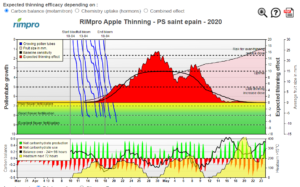Thinning model
Thinning is an essential but complex task in arboriculture. Excessive or insufficient thinning has significant economic consequences. When it comes to thinning, many factors influence the stage of application, the choice of the product, and the rates to use.
The video with detailed explanations about this model is available here
Flower Thinning
Modern fruit trees only need a few percent of all their flowers to ensure an optimal balance between yield, fruit size and return bloom. Once these flowers have given fruit, all the other flowers are in excess.
From the flowering start date provided by the user, the model simulates in the upper graph the daily opening of new flowers. As soon as the temperature of the day reaches 10 ° C, these flowers are supposed to be pollinated by insects. The growth of pollen tubes in flower styles is shown by blue descending lines. The model indicates if those flowers will have a poor, good or excellent fertilization. If the growth of the pollen tube is too slow, not all the eggs can be fertilized in time. These young fruits poorly fertilized are more likely to fall naturally.
- Check in the orchard on what date the number of flowers needed to ensure the harvest have bloomed.
- Follow the blue line of pollen tube growth of the flowers that opened that day.
- From the moment these flowers are well fertilized, you have enough fruit for an optimal harvest.
- On this date, you can start applying your thinning product on flowers (ATS in conventional or Lime sulfur in organic), to remove all the other flowers.
Fruit thinning
The need for fruit thinning depends on local factors in the orchard such as variety, initial fruit set, and previous year’s fruit harvest. The choice of the thinning agent depends on the expertise of the arborist.
Fruits are susceptible to thinning as early as 6 to 35 days after full bloom. Thinning product labels indicate the optimum time as a range of days after full bloom or in mm of fruit size.
There are at least 3 parameters that should be taken into account for a good thinning strategy :
1 / The size of the fruit. Fruits between 8 and 14 mm are considered the most sensitive. The treatments aim at this size of fruit, then it is the weather conditions (for better penetration and effectiveness of the product) which determine the final application date.
2 / The carbohydrate balance. Fruits are more sensitive to chemical thinning when the tree suffers from a lack of carbohydrates to feed all growing fruits and shoots. When low light conditions last for 3 to 5 successive days at a reasonable temperature, it results in natural fruit drop and greater sensitivity to thinning agents that interact with photosynthesis.
3/ The accumulated heat. A large amount of heat improves the efficiency of certain molecules.
Description of the model

The lower graph shows net carbohydrate production during the day (green) and carbohydrate consumption at night (red). The black line represents the carbohydrate balance accumulated over the next 96 hours. The yellow area shows the amount of effective heat accumulated over the next 72 hours. A large amount of heat improves the efficiency of certain molecules.
The upper graph calculates and predicts fruit growth from the air temperature (thin black line and pink area). From this diameter, the “baseline sensitivity” to thinning is calculated and represented by a larger black line in the upper graph, with the maximum when the fruit is 10-12mm in diameter.
The user can choose to display the expected efficiency of thinning based on the carbon balance (based on fruit size in mm and corrected for the effect of the carbohydrate balance), the efficiency of products (effective heat accumulated in the next 72 hours) or to combine these 2 pieces of information. For this last option, we gave the same weight to each factor.
For thinning agents that interact with photosynthesis (metamitrone, for example Brevis®), the carbohydrate balance in the days following application will have more impact than temperature. For thinning agents with a hormonal mode of action (eg 6BA, NAD, NAA, ethephon) the temperature in the days following application tends to have more impact on the result.